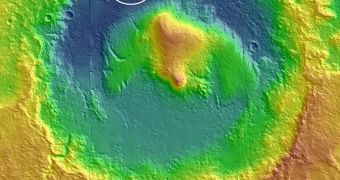As the NASA Mars Science Laboratory (MSL) rover Curiosity completes milestone after milestone, experts are analyzing the potential scientific returns of visiting Gale Crater, the mission's main target. They say that the location could finally reveal signs of ancient life on the Red Planet.
The world had liquid water on its surface more than a billion years ago, and its northern hemisphere hosted a large ocean. Various craters have already revealed signs of deltas and river channels, indicating an active water cycle.
Combining this with a denser atmosphere – which is now also lost – results in an environment that could have easily sustained basic lifeforms. It will be Curiosity's mission to determine whether this was indeed the case or not.
The $2.5 billion rover will land in Gale Crater, a massive, 154-kilometer (95.6-mile) wide hole in the Martian surface, estimated to be between 3.5 to 3.8 billion years old. The force of the impact that caused it allowed an impactor to bury itself deep into the planet's crust.
In turn, this exposed numerous geological layers – a veritable treasure trove for an advanced rover such as Curiosity – and created a 3-mile (5-kilometer) tall ejecta mountain at the core of the crater. Scientists hope to be able to drive the exploration robot up these slopes, at least for a while.
“This may be one of the thickest exposed sections of layered sedimentary rocks in the solar system. The rock record preserved in those layers holds stories that are billions of years old – stories about whether, when and for how long Mars might have been habitable,” expert Joy Crisp explains.
The researcher holds an appointment as an MSL deputy project scientist at the NASA Jet Propulsion Laboratory (JPL) in Pasadena, California. The lab, which is managed by California Institute of Technology (Caltech) for NASA, is responsible for managing the MSL mission.
“Gale Crater and its mountain will tell this intriguing story. The layers there chronicle Mars' environmental history. All the types of aqueous minerals we've detected on Mars to date can be found in this one location,” adds JPL Mars Exploration Program landing site scientist, Matt Golombek.
Already, spacecraft such as the NASA Mars Reconnaissance Orbiter (MRO) have discovered clay and sulfate signatures coming from Gale Crater, which means that Curiosity will have a lot to study even if it doesn't find any traces of alien life.
“It could take several months to a year to reach the foot of the mountain, depending on how often the rover stops along the way. There will be plenty to examine before getting to the central mound,” Golombek concludes, quoted by Space.

 14 DAY TRIAL //
14 DAY TRIAL //